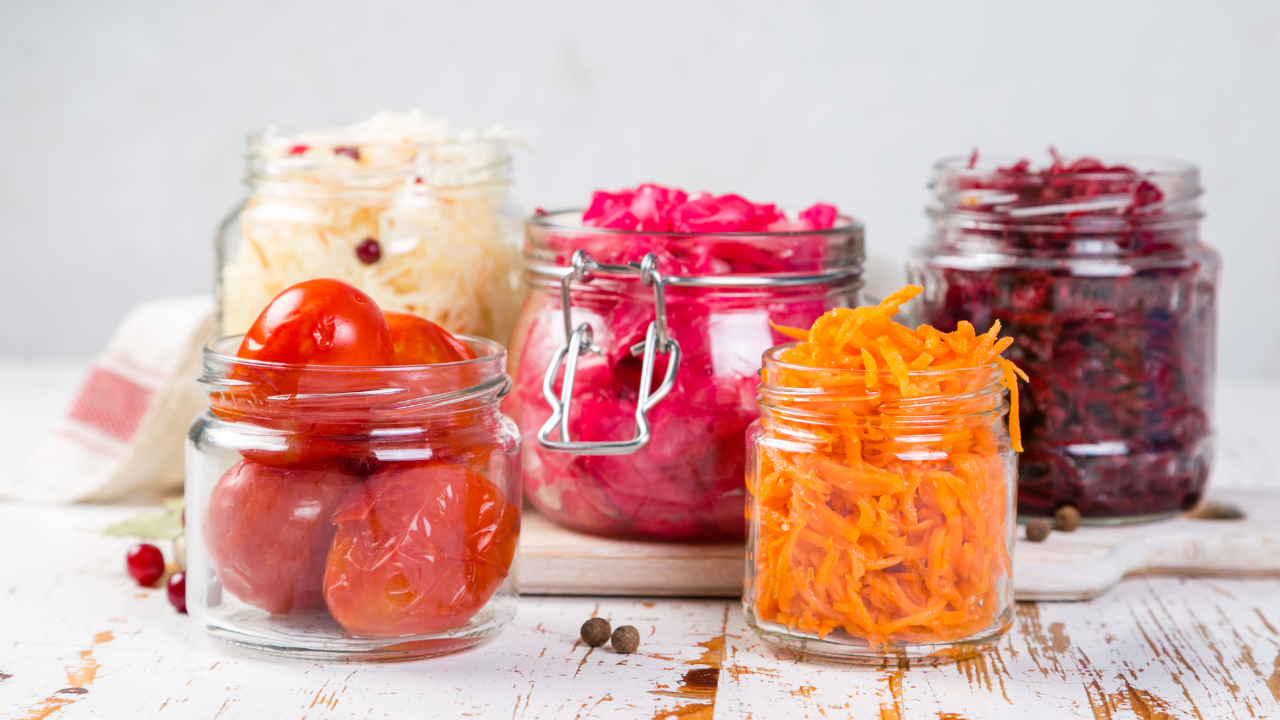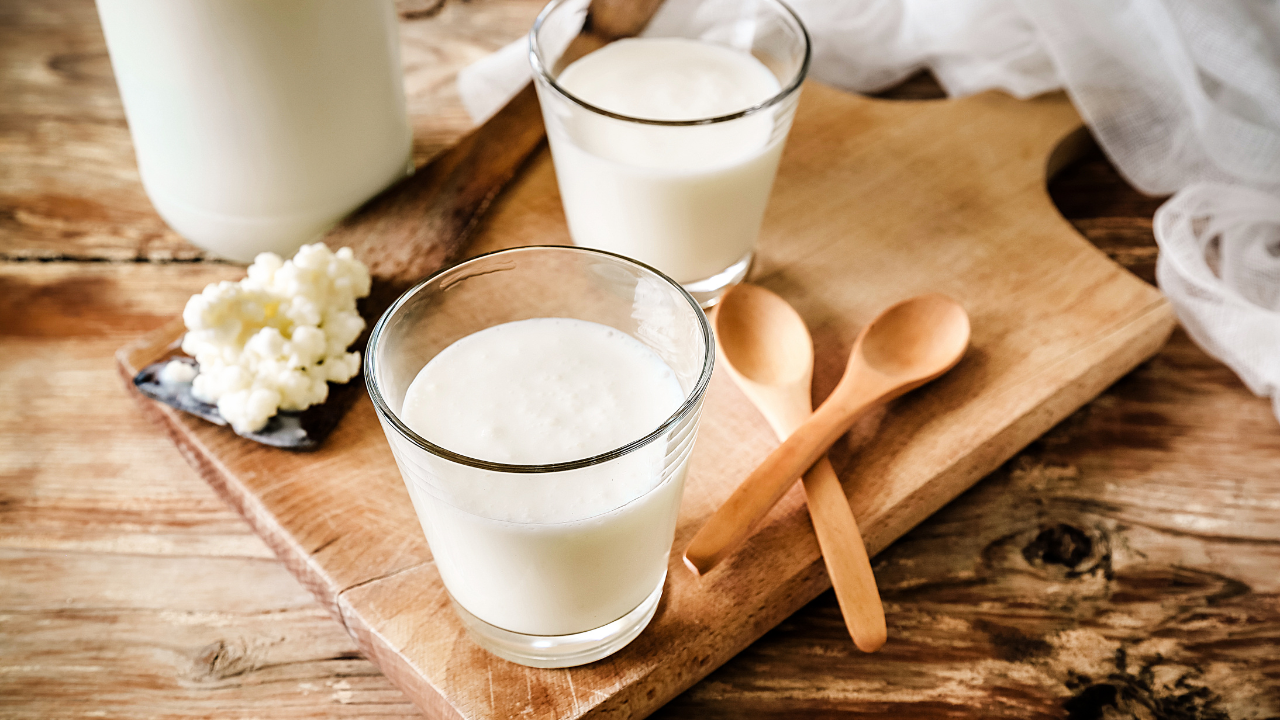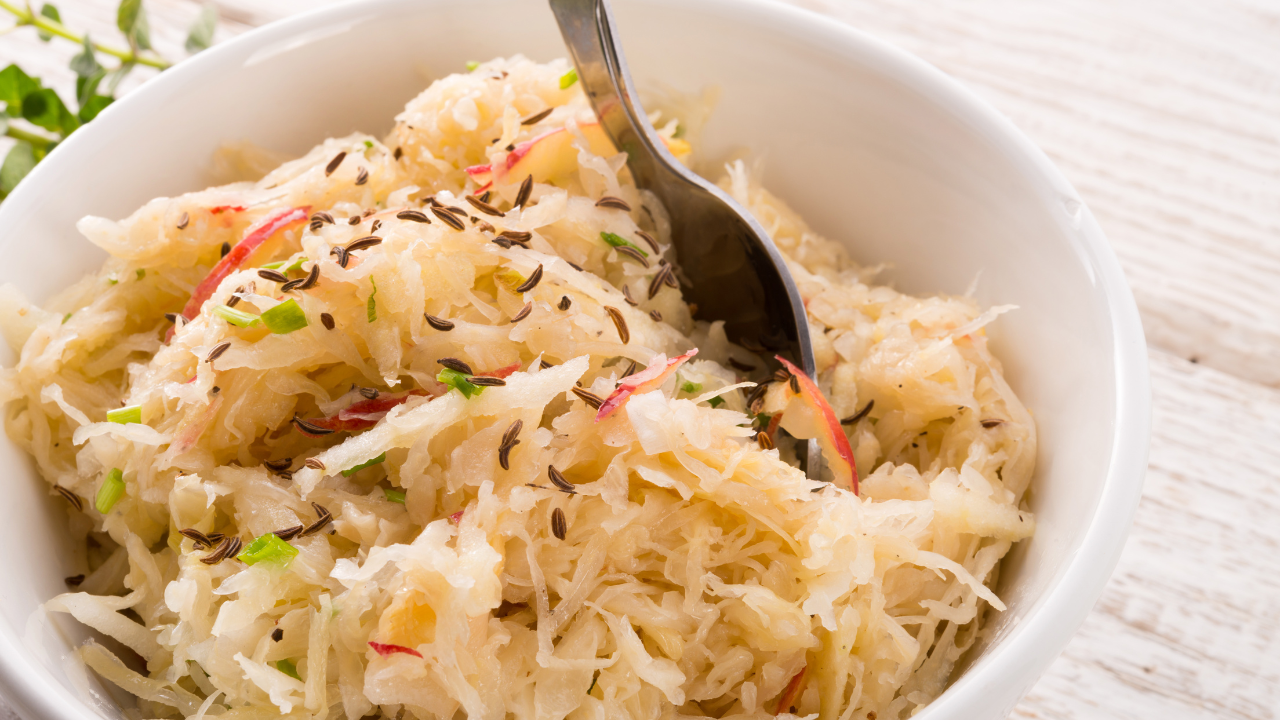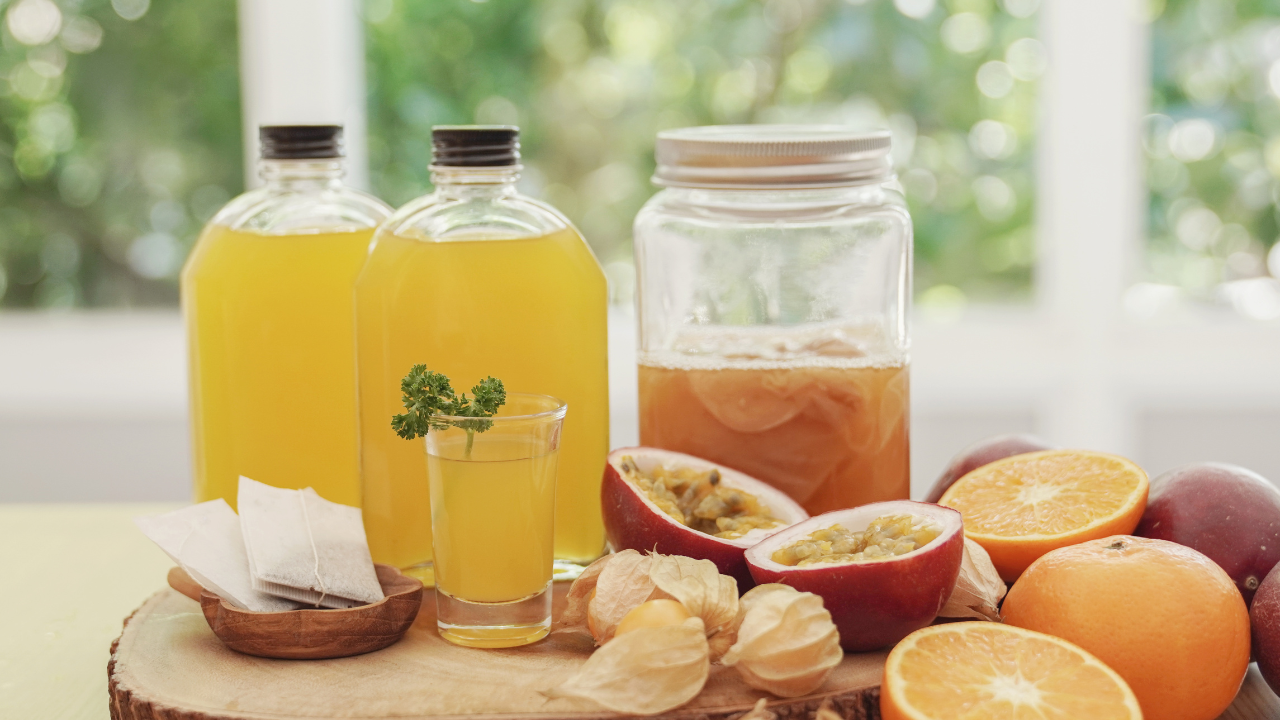Benefits of Fermented Foods: Why You Should Eat Them Daily For Better Gut and Metabolic Health
Are you wondering if there is some truth to the fermented food craze? It turns out the presumed health benefits of some of your favorite ferments are true!
Fermented foods are defined as “foods or beverages produced through controlled microbial growth, and the conversion of food components through enzymatic action.” Some popular examples you might know of are sauerkraut, sourdough bread, kimchi, and pickles. These foods have been around for hundreds of years, to help to preserve food components for longer periods of time.
For today’s article, we will discuss the main benefits of fermented foods and then examples of which foods are the most beneficial as per up-to-date evidence.
Benefits of Fermented Foods
Let’s dive into the key benefits of fermented foods for both your gut-health, as well as metabolic health!
GUT-MICROBIOME
Fermented foods contain live microbes as well as many compounds such as bioactive peptides like CLA, exopolysaccharides, and sphingolipids which have been shown to help support a diverse microbiome, reduce inflammation, and consequently help improve overall digestive health.
A recent 17-week dietary intervention-based study showed that fermented foods boost microbiome diversity, and reduce markers of inflammation. The study focused on the effects of a plant-based high-fiber food versus a high-fermented food diet on the gut microbiome in healthy adults. The results found that the high-fermented food diet increased microbiome diversity more than the high-fiber diet.
As I chat about in my FREE masterclass ‘5 Secrets to Find Freedom From IBS & Painful Bloating’. - plant food diversity is incredibly important for our gut-microbiome health long-term!
REGULATE STOMACH ACID LEVELS
Fermented foods may also help to improve stomach acid levels, which can improve gut motility, reflux & heartburn, bloating, undigested food in stools, nausea, and dysbiosis. A common underlying factor in SIBO and IBS is slow gut motility which can be attributed to low stomach acid levels. Fermented foods may help to improve this over time.
ANTI-INFLAMMATORY PROPERTIES
As mentioned in the study above, fermented foods have been shown to help reduce inflammatory markers in those consuming them. In this specific study, participants on the high fermented food diet ate an average of 0.5 servings and gradually increased their daily intake over the 13 weeks. The study concluded that a high-fermented food diet decreases markers of host inflammation at the end of the study. This was accredited to some types of cytokines, chemokines, and other inflammatory serum proteins that decreased over the fermented food intervention. As high cytokine levels have been linked to chronic low-grade inflammation, these findings suggest fermented foods hold anti-inflammatory effects on the body.
METABOLIC HEALTH
Additionally, fermented foods may also provide benefits for metabolic health including blood sugar-regulating, and blood pressure-lowering activities.
SOURCE OF VITAMIN K2
Some fermented foods such as sauerkraut, and natto are good sources of Vitamin K2. This specific nutrient, which is difficult to find in today’s modern diet, is important for hormones, heart health, skin, hair, and nails.
Types of Fermented Foods
So now that you better understand the potential benefits associated with fermented foods, let’s talk about how and what to incorporate into your diet!
The best sources (evidence-supported) include:
KEFIR
Defined as fermented milk, kefir is rich in probiotics that can help improve balance in the gut which helps improve digestion. Kefir also contains beneficial bacteria such as Lactic Acid Bacteria (LAB). In kefir, there are many strains of Lactobacilli however the most commonly studied strains have been linked to lower levels of inflammation, lower serum cholesterol levels, improved digestion, and gut health. Lactobacillus kefiri specifically, has been found to inhibit the growth of various harmful bacteria, including Salmonella and E. coli. Thus making kefir a beneficial additive to maintain gut microbiota balance. Also higher in protein, kefir is a food that can keep you feeling fuller longer.
Tips to Eat: Try mixing with berries and seeds, or add to a smoothie with fruit and greens for breakfast.
SAUERKRAUT
Defined as fermented cabbage with a signature sour and salty taste, sauerkraut is a versatile fermented food option. Unprocessed lacto-fermented sauerkraut can contain LAB which can promote lactose digestion and aid in the treatment of IBS symptoms.
Tips to Eat: Consider adding it to scrambled eggs, or top on a sandwich, soup, or salad.
OTHER FERMENTED VEGGIES (PICKLES, BEETS, CARROTS)
According to research, some of the most beneficial fermented vegetables include cucumbers (in salt NOT vinegar), carrots, radish, and celery. Some vegetables are fermented with LAB via spontaneous fermentation by natural microflora, or fermentation via starter cultures. Commonly LAB fermented vegetables include cabbage, red beet, carrot, celery, and tomato. Each vegetable will have its own unique set of microorganisms, depending on how it is fermented, how long, and what it is fermented with.
For example, cucumbers can be fermented in a Taiwan dish called Jiang-gua with salt and contain Weissella cibaria, W. hellenica, Lactobacillus Plantarum, Leuconostoc lactis, Enterococcus casseliflavus. It can also be fermented without salt in the Nepali dish Khalpi which contains the microorganisms Lactobacillus Plantarum, and Pediococcus Pentosaceus.
Tips to Eat: These can be enjoyed on stir fry (to season), on sandwiches, soups, or salads.
NATTO
Defined as fermented soybeans these “sticky beans” make a traditional Japanese dish. Natto is produced with B. subtilis (natto) spores, soybeans, and water. The nutritious quality of natto is dependent on the quality of the B. subtilis and the type of soybeans involved. Interestingly, natto made with black soybeans has been perceived as holding a higher nutritious value in scientific literature.
Due to the B. subtilis content, benefits include a high nattokinase content. Nattokinase is suspected to play a supportive role in protecting the cardiovascular system from cardiovascular disease.
Additionally, natto is high in K2 as nattokinase encourages its production. The high vitamin K2 ensures proper calcium regulation which is important for body homeostasis.
Tips to Eat: Natto can be enjoyed seasoned or mixed with soy sauce, mustard, and green onion on rice but can also be enjoyed in sushi like nori rolls.
KIMCHI
Defined as a salted and fermented cabbage with Korean radish & chili powder, and often onions, garlic, and ginger as well. Since kimchi is also fermented with various forms of LAB.
Studies have shown that kimchi holds some probiotic benefits including a positive effect on the microbiome of the intestines. This includes a LAB-produced metabolite called bacteriocins which could inhibit sensitive pathogens in the human intestines to treat some pathogen infections without significantly compromising the composition of the microbiota. Overall, kimchi’s probiotics can help support a more favorable gut microbiota.
Tips to Eat: Use as a condiment in buddha bowls, mix with eggs, in wraps, or to add some spice to a burger.
SOURDOUGH BREAD
Defined as bread made by the fermentation of dough via wild yeast and lactobacillus bacteria, sourdough is an easily digested and naturally low-FODMAP-friendly option. Sourdough has been known to benefit metabolic health due to its lower glycemic index (having a less drastic effect on blood sugars), improve digestibility through reduced content of non-digestible FODMAPs such as fructan and raffinose, and has been associated with positive gut microbiome changes (specifically increased Bifidobacteria in the microbiome upon regular consumption).
Tips to Eat: Try it as a replacement for your regular bread!
Fermented Foods vs. Probiotic Foods
Not all fermented foods contain probiotics and it is important to know the difference!
Probiotic foods refer to foods with live microorganisms that can be beneficial to the host (you) when consumed in proper amounts. In order for living microbes to be probiotics, they must be isolated from a human, survive in your intestine after ingestion (being eaten), have a proven benefit to you, and be safely consumed. Probiotics are often seen in a pill or a powdered form used to treat specific conditions or symptom relief. Probiotics can also be found in some foods, most of which are fermented. An example would be a probiotic yogurt, such as Activia probiotic yogurt. Yogurt is fermented milk via beneficial LAB. Note that only some yogurts have added probiotics so always make sure to read the labels of the products you purchase to find out what probiotics and how much are present.
Fermented foods refer to foods that have undergone a chemical breakdown by bacteria, yeasts, or other microorganisms, typically involving effervescence and giving off heat. Some fermented foods will contain live microbes such as probiotics (ex. kefir, yogurt, etc.) and others will not (ex. beer/wine). Sometimes these foods may undergo steps that remove probiotics or make them inactive. This can be done through baking/exposing to high heat (kill microbes) or filtering (remove microbes). Thus, not all fermented foods contain probiotics. However, as mentioned in our introduction, fermented foods can contain other beneficial compounds as a result of the fermentation process such as bioactive compounds as well as increased antioxidant activity of the food fermented!
Although fermented foods often hold some beneficial contents, they are not guaranteed to function the same as a probiotic food would. Not all fermented foods are created equal and therefore cannot be assumed to function as specific as a probiotic would. Some fermented foods also can contain high amounts of added fat, sugar, or salt which can further alter their nutritional contents. Therefore, it is important to read nutrition labels to be aware of what you are intaking to better understand its role in your body.
P.S. Want to save TIME, STRESS and MONEY while optimizing your gut health and wellness with a proven meal planning and prepping system?
Grab the Ultimate Gut-Friendly Meal Planning Mini Course + Resource Bundle NOW!
Tips for Choosing Fermented Products
When choosing fermented veggies, look for products that are naturally fermented and not pasteurized/ processed. Also look for words such as “raw”, “naturally fermented”, “alive”, “live”, “keep refrigerated” or “needs refrigeration,” “perishable,” or “naturally occurring lactobacilli” on the jars or labels when shopping. Choose options fermented with salt (NOT vinegar) to ensure the presence of probiotics.
Additionally, to avoid killing the important bacteria in these nutrient-rich foods, avoid cooking on high heat and instead opt for using them as a topping when possible.
When choosing a sourdough bread, make sure it is traditional sourdough with live starter cultures. Look for: minimal ingredients (less than 10), whole grain flours, and NO yeast (should contain bacterial cultures). Check that it is fermented for at least 4-6 hours.
Improving Tolerance to Fermented Foods
While I listed the benefits and top sources of fermented foods, I recognize that not all of these you may be able to tolerate just yet. Oftentimes with SIBO (Small Intestinal Bacterial Overgrowth), there is underlying histamine intolerance, so these foods may worsen your reaction, due to their higher levels of histamine.
In addition, for those with IBS & SIBO, some of these foods are higher FODMAP (such as sauerkraut and regular Kefir) in certain servings, which may affect your reaction to them and can also trigger symptoms.
What I would suggest is working with a specialized dietitian to identify your specific FODMAP and chemical triggers and work to strengthen your digestion, in order to improve your diet diversity as well as improve your tolerance to these foods over time.
If you are looking for personalized support, don’t hesitate to reach out and apply for 1:1 coaching with me.
Final Thoughts
As you can see, there are a plethora of fermented foods, which historically have been around for 100s of years. And for good reason, thanks to their anti-inflammatory properties, gut-microbiome, and metabolic health benefits!
In summary, try to include them in your diet regularly, and experiment with these foods in different recipes to see which you enjoy the most. And if you are struggling with tolerance to some fermented foods, don’t hesitate to reach out for personalized support.
Hope you enjoyed today’s post! Feel free to leave me a comment below, and for more IBS, SIBO, and gut-health tips, follow me on my Instagram at @leighmerotto_rd

BE SURE TO FOLLOW ME HERE
References:
https://www.healthline.com/health/how-to-increase-stomach-acid#treatment
https://irritablebowelsyndrome.net/food/fermented-foods-low-fodmap-diet
https://pubs.rsc.org/en/content/articlelanding/2018/fo/c8fo00968f/unauth#cit36
https://cdhf.ca/health-lifestyle/probiotics-vs-fermented-foods/
https://my.clevelandclinic.org/health/articles/14598-probiotics
















